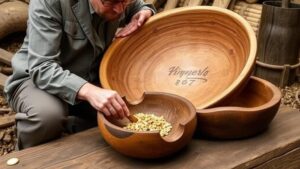How to Choose the Best Gold Pan for Your Prospecting Needs
How to Choose the Best Gold Pan for Your Prospecting Needs
Choosing the right gold pan is a critical step for anyone looking to engage in gold prospecting. The right pan can significantly enhance your efficiency and effectiveness in finding gold. This article will provide a detailed guide to selecting the best gold pan tailored to your prospecting needs, focusing on essential features, materials, sizes, and techniques.
Understanding the Basics of Gold Panning
Gold panning is a simple method of separating gold from other materials such as sand and gravel using a pan. process relies on the principle of density–gold is much denser than most other materials found in riverbed deposits. A well-chosen gold pan allows you to maximize your chances of finding gold more effectively.
Key Features to Consider When Choosing a Gold Pan
When selecting a gold pan, several fundamental features must be considered to ensure it meets your prospecting requirements:
- Material: Gold pans come in various materials, including plastic, metal, and fiberglass. Plastic pans are the most popular due to their lightweight nature and durability. are also less prone to rust and corrosion. Metal pans, while more durable, can be heavier and may rust.
- Size: Gold pans typically range from 8 to 20 inches in diameter. Smaller pans are easier to navigate but hold less material, while larger pans allow for more material but can be cumbersome.
- Color: The color of a gold pan can impact visibility. Black pans help highlight the shiny gold flecks, making it easier to spot small nuggets.
- Riffles: Riffles are ridges inside the pan that help trap gold particles. The number and design of riffles can affect their effectiveness at retaining gold.
Types of Gold Pans
There are several types of gold pans available, each with unique benefits and drawbacks:
- Traditional Round Pans: This is the most common type, often characterized by smooth surfaces and a notable point for efficient swirling. Ideal for beginners and experts alike.
- Sluice Pans: These pans have a more complex structure designed for faster processing. can hold more material and work well in conjunction with a sluice box.
- Specialized Designs: Some pans are designed for specific locations or materials, such as dredging or highbanking, making them suitable for more advanced techniques.
Factors Influencing Your Choice
When deciding on a gold pan, consider the following factors that can influence your choice:
- Your Experience Level: Beginners may opt for simpler, more lightweight pans, whereas experienced prospectors might prefer specialized designs for advanced techniques.
- Location and Conditions: The specific environment where you will be prospecting (e.g., river, mountain stream, or desert) can dictate the most suitable pan. For example, a smaller, lightweight pan may be effective in remote areas, while larger pans may work better in rivers with a significant current.
- Hand Size and Comfort: Ensure the pan feels comfortable and manageable in your hands. Pans with ergonomic designs can reduce fatigue during prolonged use.
Testing & Evaluating Your Gold Pan
Once you have selected a potential gold pan, testing it in the field is essential to evaluate its performance.
Consider the following testing methods:
- Field Tryouts: Use the pan at various water sources to assess ease of use and efficiency in trapping gold.
- Material Experimentation: Try different types of materials in your pan to see how well it retains gold particles.
- Seek Feedback: Connect with experienced prospectors who can provide insights and recommendations based on their experiences.
Real-World Application: Success Stories
Many amateur and professional prospectors have found success by carefully selecting their gold pans. For example, Tom, a hobbyist from California, switched from a metal pan to a lightweight plastic one. The change allowed him to travel further into remote streams, resulting in the discovery of several small nuggets over the course of a season.
Also, Julie, an experienced prospector, shared that using a larger sluice pan has reduced her processing time and increased her yield. She could handle larger amounts of material, which translated directly into more gold recovered within her limited prospecting trip times.
Conclusion and Actionable Takeaways
Choosing the best gold pan for your prospecting needs involves understanding the critical features, types, and factors influencing your choice. Test different pans in real-world conditions to see which one suits your style. Successful prospectors often highlight the impact of a well-chosen gold pan on their overall success.
To enhance your gold prospecting experience:
- Research various gold pan types and materials.
- Evaluate size and comfort to match your conditions.
- Experiment with your chosen pan to establish its effectiveness.
With the right gold pan in hand, you can embark on your prospecting adventures with confidence, maximizing your chances of striking gold.


